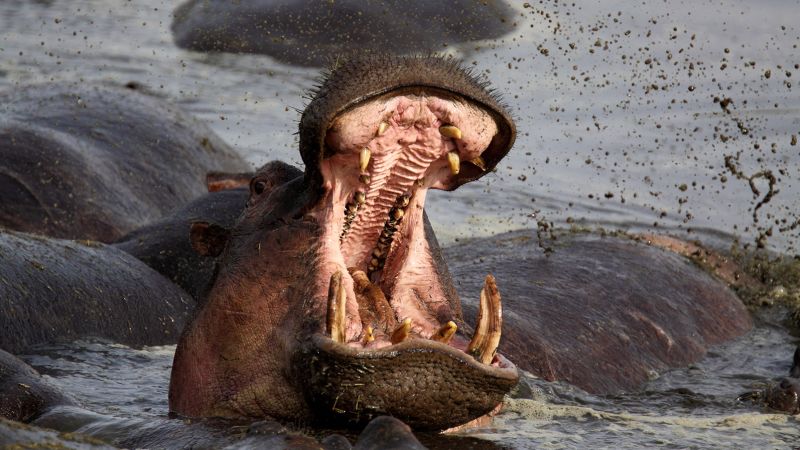CNN
—
Paul Templer was living his best life.
He was 28 and conducting tours in his native Zimbabwe, with a focus on photographic safaris.
He had been away for a few years, including a stint in the British army. But he had returned to Africa’s bush country “and fell back in love with it. The wildlife, the flora, the fauna, the great outdoors, the space – just everything about it. I was at home.”
Templer said Zimbabwe’s guide certification program was rigorous, and there was a lot of pride among the guides who passed. He reveled in showing tourists the area’s majestic wildlife – including the water-loving, very territorial hippos.
“It was idyllic,” he told CNN Travel recently. “Life was really, really good – until one day I had a really bad day at the office.”
March 9, 1996. A Saturday. Templer learned a good friend who was to lead a canoe safari down the Zambezi River had malaria. He agreed to take his pal’s place. “I loved that stretch of the river. It was an area I know like the back of my hand.”
The expedition consisted of six safari clients (four Air France crewmembers and a couple from Germany), three apprentice guides plus Templer. They had three canoes – clients in the first two seats and a guide in the back. Then one apprentice guide was in a one-person safety kayak.
And down the famed Zambezi they went. “Things were going the way they were supposed to go. Everyone was having a pretty good time.”
Eventually, they came across a pod of about a dozen hippos. That’s not unexpected on the Zambezi, Africa’s fourth-longest river. They weren’t alarmed at first as they were at a safe distance. But “we were getting closer, and I was trying to take evasive action. … The idea was let’s just paddle safely around the hippos.”
Templer’s canoe led the way, with the other two canoes and kayak to follow. He pulled into a little channel waiting on the others. But the third canoe had fallen back from the group and was off the planned course. Templer’s not sure how that happened.
Suddenly, there’s this big thud. And I see the canoe, like the back of it, catapulted up into the air.
Paul Templer
“Suddenly, there’s this big thud. And I see the canoe, like the back of it, catapulted up into the air. And Evans, the guide in the back of the canoe, catapulted out of the canoe.” The clients managed to remain in the canoe somehow.
“Evans is in the water, and the current is washing Evans toward a mama hippo and her calf 150 meters [490 feet] away. … So I know I’ve got to get him out quickly. I don’t have time to drop my clients off.” He yells to Ben, one of the other guides, to retrieve the clients who were in the canoe that had been attacked.
Ben got the clients to safety on a rock in the middle of the river that hippos couldn’t climb.
Meanwhile, Templer turned his canoe around to get Evans. The plan was to pull alongside of him and pull him into Templer’s canoe.
“I was paddling towards him … getting closer, and I saw this bow wave coming towards me. If you’ve ever seen any of those old movies with a torpedo coming toward a ship, it was kind of like that. I knew it was either a hippo or a really large crocodile coming at me,” he said.
“But I also knew that if I slapped the blade of my paddle on water … that’s really loud. And the percussion underwater seems to turn the animals away,” he said. “So I slapped the water, and as it was supposed to do, the torpedo wave stops.”
He was getting closer to Evans, but they were also getting closer to the female and calf.
“I’m leaning over – it’s kind of a made-for-Hollywood movie – Evans is reaching up. … Our fingers almost touched. And then the water between us just erupted. Happened so fast I didn’t see a thing.”
What happened next was nightmarish and surreal.
“My world went dark and strangely quiet.” Templer said it took a few seconds to figure out what was going on.
“From the waist down, I could feel the water. I could feel I was wet in the river. From my waist up, it was different. I was warm, and it wasn’t wet like the river, but it wasn’t dry either. And it was just incredible pressure on my lower back. I tried to move around; I couldn’t.
“I realized I was up to my waist down a hippo’s throat.”
There’s a good reason a fully grown hippopotamus can fit a large portion of a fully grown adult in its mouth. Hippos can grow up to 16.5 feet long (5 meters), 5.2 feet tall (1.6 meters) and weigh up to 4.5 tons (4 metric tonnes), according to National Geographic.
They sport enormous mouths and can open their strong jaws to 150 degrees.
Their teeth might be the most frightening thing of all. Their molars are used for eating plants, but their sharp canines, which might reach 20 inches (51 centimeters), are for defense and fighting. Their bite is almost three times stronger than that of a lion. One bite from a hippo can possibly cut a human body in half.
They’re found naturally in various parts sub-Saharan Africa, particularly in East and Southern Africa, living in or near rivers and other water sources. (And they are an invasive species in Colombia thanks to escapees from drug lord Pablo Escobar’s menagerie).
Hippos are very territorial and might aggressively attack any animal encroaching on their territory, including hyenas, lions and crocodiles.




